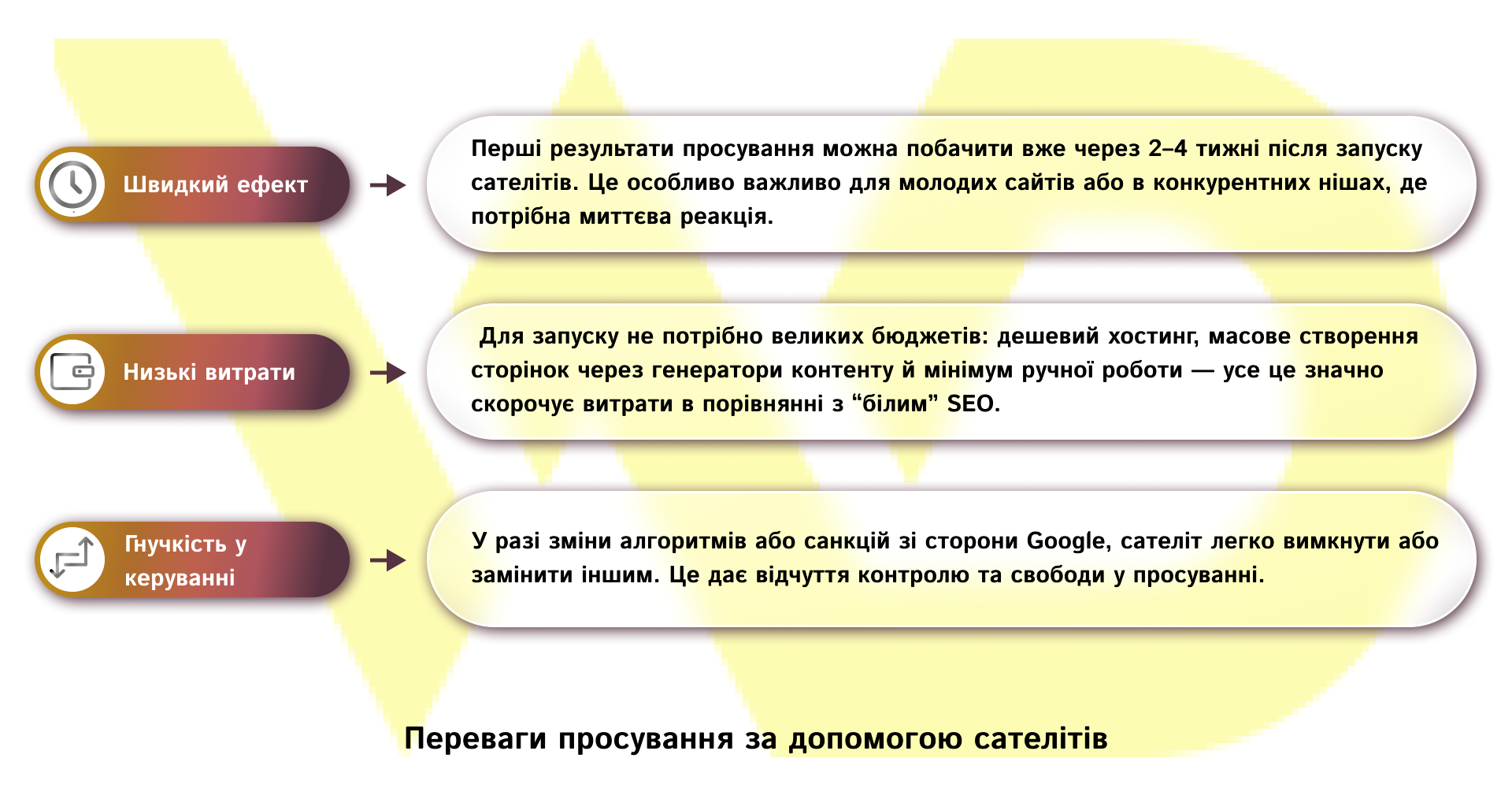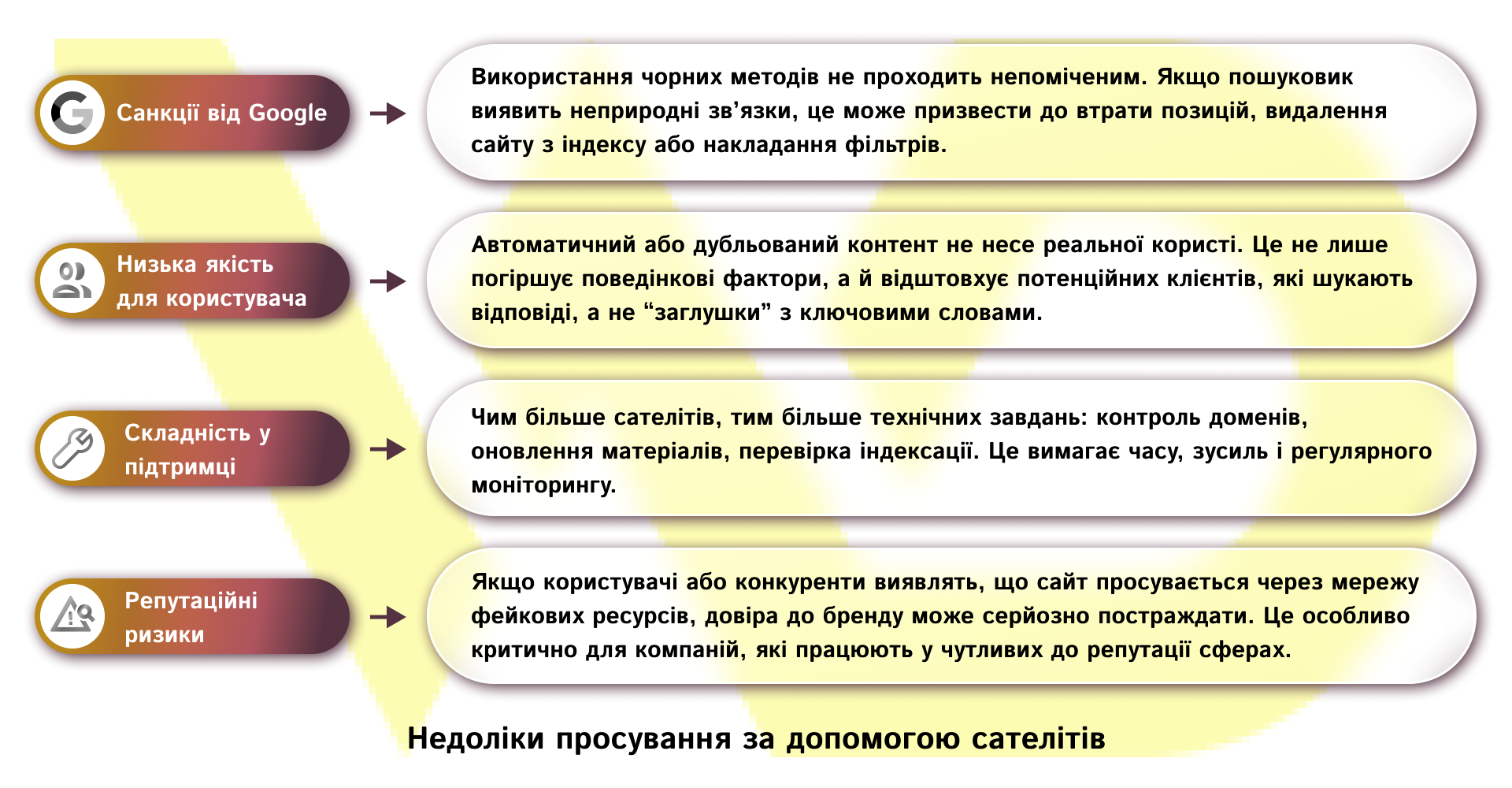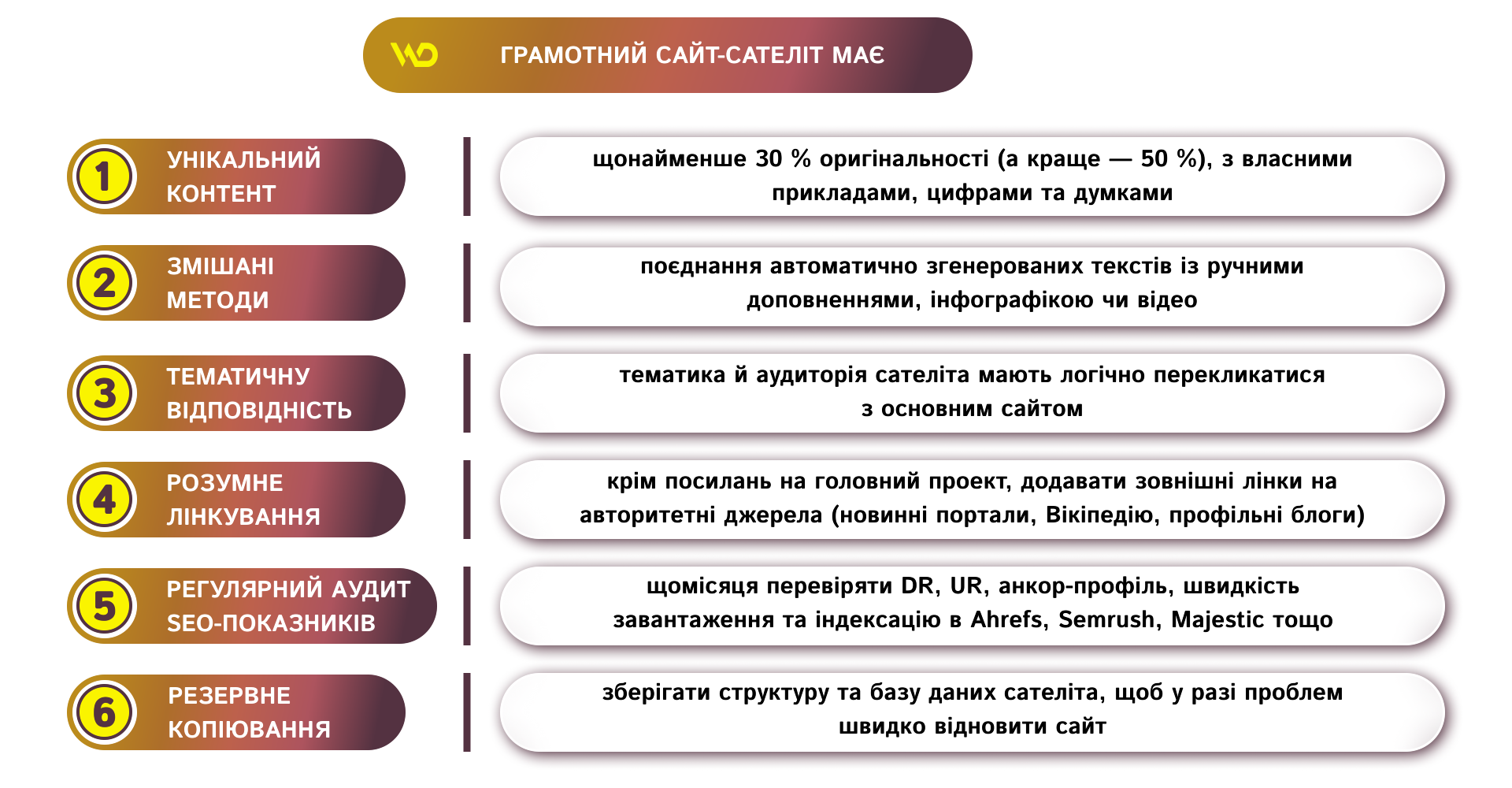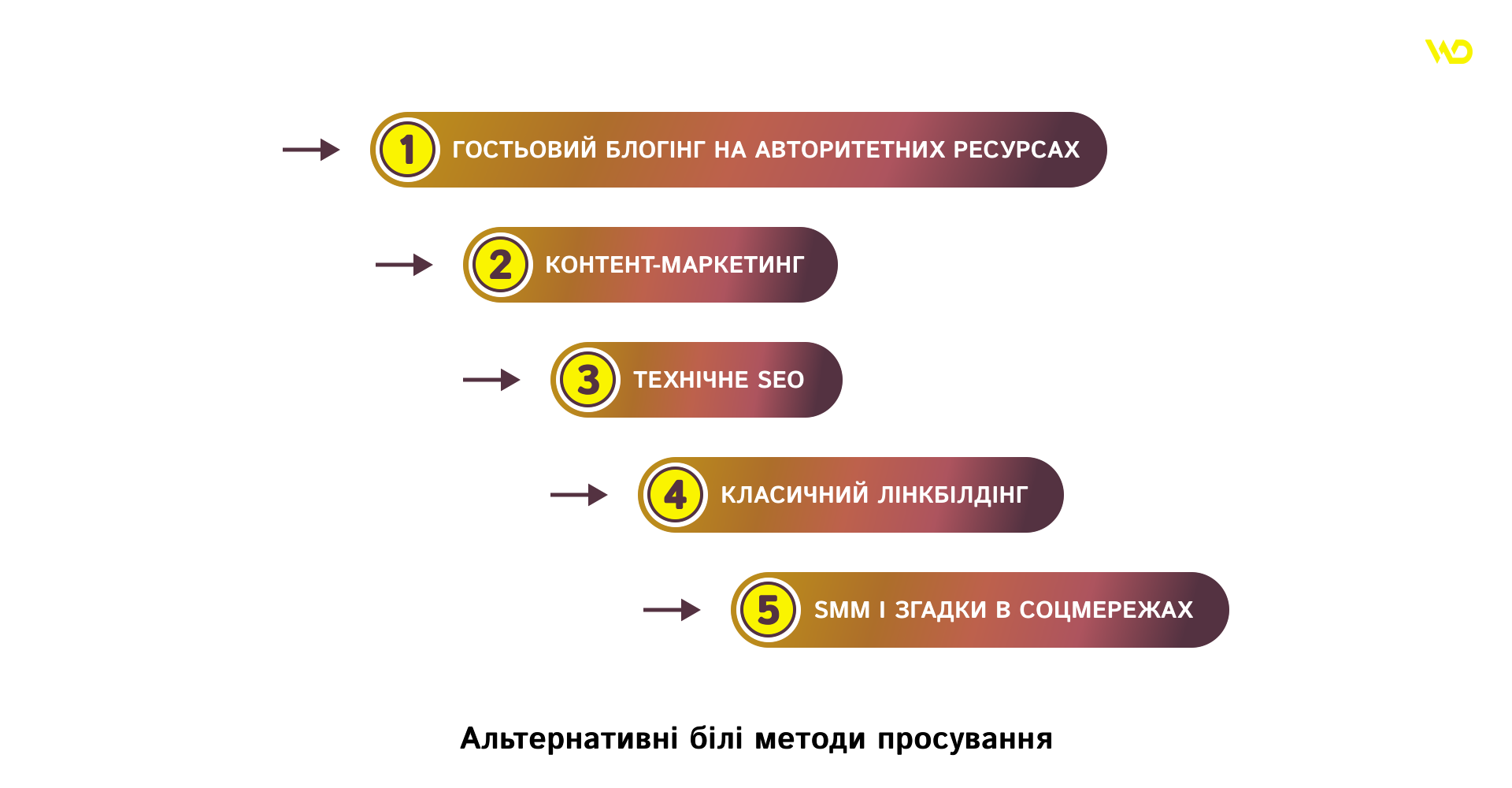Content of the article
- /01 What is a satellite site and what is it used for?
- /02 How to create a satellite site?
- /03 Pros and cons of SEO promotion with the help of satellites
- /04 Types of satellite sites
- /05 How to use satellites correctly?
- /06 Errors when creating satellites
- /07 Alternative white hat methods of promotion
- /08 Conclusions: is it worth using satellites?


SEO specialists use various techniques to make a website more visible in search engines. Some of these techniques are called «white hat» because they comply with Google’s rules. Others are called «black hat» and include satellites or satellite sites. These are additional web resources created exclusively for the purpose of quickly building external links. In this article, we will analyze in detail what satellites are, why they are used, how they are made, what types they are, and consider their advantages and disadvantages. In the end, we will consider whether it is worth the risk to use such promotion methods.
What is a satellite site and what is it used for?
A satellite site is a small auxiliary web resource on a separate domain or subdomain with a simplified design and minimal content. It is not intended for end users: there are no comments or active visitors, but there are several thematic articles or directories that link to the main resource. This approach creates the impression of a wider network of recommendations that is noticed by search algorithms.
Black hat SEO specialists use satellites to quickly raise the position of the main resource at minimal cost. This is a kind of experimental platform where the main goal is not to attract an audience, but to technically build up external relations. With the help of a network of similar resources in different parts of the Internet, you can:
- build authority through a large number of external links;
- test which topics are more likely to «catch» the audience without risking the reputation of the main site;
- hide connections between resources through different hosting and IP addresses;
- quickly disable problem domains in case of filters or algorithm changes.
Despite the potential for operational growth, satellites are not designed for long-term brand building and can become a burden in your marketing strategy.
How to create a satellite site?
Launching a satellite is not just about registering a domain and adding links. To ensure that such a web resource really works for the benefit of the main site and does not fall into the field of view of search filters, it is important to think through everything to the smallest detail: from technical settings to content structure. Let’s take a closer look at the key elements that should be taken into account when creating seo satellite sites.
Domain selection
Start by selecting domains from different registrars and with different zones (.com, .net, .info, etc.). Expired domains with little history can be a good option, as they are already partially «trusted» by search engines. Make sure that the WHOIS data contains different contact persons to hide the connection to the main project.
Placement on different hosting sites
To make your network less visible, use multiple hosting providers. Even if these are the cheapest tariff plans, it is important that the resources have different server IP addresses and geographical locations. This will make it harder for Google to detect that all satellites belong to the same company.
Content preparation
On each satellite, post articles of 300-500 words with unique headlines and introductions. Provide at least 30% original content: add your own conclusions, examples, or simple infographics. This will help reduce the risk of sanctions and make the satellite more «alive».
Linking
Insert links to the main resource in key blocks: in the first paragraph, in thematic menus, footer, or sidbar. A variety of anchors (link text) and their natural integration into the content will increase the efficiency of the network.
IP rotation
To prevent Google from «linking» your domains, connect satellites through different proxies or VPNs. Even a simple change of the source IP once a week will make it difficult for Google to automatically detect the connection between sites.
Monitoring of indexing
Regularly check the status of each site in Google Search Console and SEO tools (Ahrefs, Semrush). Keep track of the number of indexed pages, indexing speed, and notifications of potential sanctions.
Regular updates
Add new materials or update old texts every month so that satellites don’t get «frozen» in the index. Even a small addition or corrected statistics will show search engines that the resources are maintained and reduce the risk of being excluded from the search results.
Creating satellite sites is a whole technical process that requires attention to detail. If done carelessly, it can easily harm your entire SEO strategy.
Pros and cons of SEO promotion with the help of satellites
Satellite resources may look like an attractive strategy for rapidly growing search engine rankings and strengthening the main resource. But like any tool, they have their strengths and weaknesses. Before using such methods, you should weigh the pros and cons.


Before launching a satellite, it is important to realize that short-term gains can lead to long-term losses. Such an SEO strategy requires caution and a clear understanding of the consequences.
Types of satellite sites
Satellites can vary greatly in terms of complexity, structure, and goals pursued by their owner. Depending on the promotion strategy, budget, and technical capabilities, different types of such resources are used. Each type has its own peculiarities that affect efficiency and risk level. Let’s consider them.
- Simple blogs.
This is the simplest type of satellite. They usually consist of automatically generated articles and a minimum number of pages. The main goal is to insert a link to the main selling resource without spending extra resources.
- Microsites.
They have 5 to 10 pages and are created manually for a specific topic or niche. Such resources have a higher quality of content and are more thoroughly optimized for search engines, so they arouse less suspicion.
- PBN (Private Blog Network).
These are closed networks of sites that are hosted on their own servers or separate hosting. The owner has full control over them, from content to technical condition, and also conducts audits to maintain the visibility of white hat SEO optimization.
- Multi-domains.
These are several domains with similar names, for example: example-shop.com, example-store.net. This approach allows you to create the impression of a wide presence on the web and disguise the real center of promotion.
- Hybrid resources.
Combine white and black methods: for example, a resource may contain both useful materials (guides, infographics) and automated texts. This allows you to bypass filters and look more legitimate, but requires more effort.
When choosing the type of satellite, you should focus not only on the speed of the result but also on a long-term strategy. The better and more natural the resource looks, the lower the risk of sanctions and the more useful it is for the main website.
How to use satellites correctly?
For satellites to work efficiently and not arouse suspicion in Google, it is important to follow certain rules.

Using such resources without a well-thought-out strategy can quickly negate all efforts – so every stage should be planned and controlled. A properly configured satellite can bring benefits without unnecessary risk if it is prepared with an understanding of how search engines work.
Add uniqueness
Content should be at least 30% unique, preferably 50%. Completely copied or generated materials are easily detected by search algorithms and can result in sanctions. It is worth rewriting texts manually, adding your own examples, figures, and opinions.
Mix methods
A combination of white and black methods often yields better results than the extremes. For example, you can add manual additions, images, infographics, or even videos to automated text to increase the credibility and naturalness of the resource.
Topics and audience
The satellite should be thematically related to the main resource. For example, if the main site is about children’s clothing, the satellite can be about children’s fashion, childcare, etc. The thematic connection is perceived by search engines as logical and natural.
High-quality external links
To reduce suspicion, dilute links to your main site with links to popular, reliable resources: news portals, Wikipedia, specialized blogs. This creates the appearance of a balanced resource, not just a promotion tool.
Regular audits
Check technical and SEO indicators on a monthly basis in systems such as Ahrefs, Semrush, Majestic. Pay attention to DR, UR, anchor profile, loading speed, indexing. This will help you identify problems in time and avoid sanctions.
Backup and restore
Even temporary satellites should be backed up regularly. If a blockage or technical error occurs, thanks to a backup, you can quickly restore your resource without losing all your efforts.
Proper use of satellites is not only about technical implementation, but also about analytics, testing, and attention to detail. If you ignore these tips, the risks increase significantly.
Errors when creating satellites
Mistakes at the stage of creating and launching satellite sites are common and costly. The most common one is complete duplication of content. When the same or very similar articles are published on all satellites, search engines instantly notice this. Such resources look suspicious, and instead of the expected rise in the rankings, the owner receives filters or even a ban.
Another big mistake is using the same hosting for the entire network. This makes the connection between sites obvious, even if the content on them is different. Google takes into account IP addresses, DNS data, and other technical indicators that can easily indicate that several web resources belong to the same owner.
Link building too fast is also dangerous. If a satellite suddenly «pumps» hundreds of links to the main web resource in a few days, the search engine perceives this as artificial interference with the ranking algorithms, which indicates a PBN network or other black hat methods.
Another common mistake is ignoring analytics. When launching satellites, some owners forget to regularly check indexing, search visibility, traffic indicators, or changes in links. Without this, it is impossible to notice problems in time or adapt the strategy to new algorithms.
And finally, the lack of a plan. If there is no clear publication schedule, no understanding of the purpose of each resource, no distribution of topics and roles in the network, everything quickly turns into chaos. Not only does such a «network» not work, but it can also harm the main site.
To avoid such mistakes, it is important to treat each satellite as a full-fledged project: with a separate plan, goal, audience, and development logic. It takes effort, but otherwise, you risk losing more than you gain.
Alternative white hat methods of promotion
If you don’t want to risk sanctions from search engines or lose the trust of your audience due to the use of satellites, you should pay attention to white hat SEO promotion.

These are honest, long-term, but reliable ways to increase your website’s rankings on Google and build a strong niche authority. They require more time and effort, but the result will be stable and without the threat of blocking.
Looking for a safe way to improve your website's ranking?
At WEDEX, we only use white hat SEO methods — no manipulation or risks. Content, technical optimization, link building, and a strategy that works for long-term results.
Here are some effective tools that are worth using.
- Write expert articles for well-known websites in your field. This not only brings you quality backlinks, but also gives you the opportunity to make yourself known to a new audience.
- Create useful materials: guides, checklists, case studies, infographics, comparisons – anything that answers real user requests. Such content is well indexed and works long after publication.
- Take care of the technical side: page loading speed, adaptability to mobile devices, proper use of headers, structured data, and micro-markup. This directly affects the position of the resource in search.
- Look for relevant sites to exchange or post links to. These can be industry directories, affiliate pages, or thematic blogs. The key is quality, not quantity.
- Make it a rule to have an active presence on social media. Mentions, shares, and click-throughs increase overall brand awareness, and Google considers social media activity as part of a website’s credibility.
White hat methods are an investment in the future. They do not give an instant result, but they allow you to build long-term positions, avoid penalties, and create a healthy ecosystem around your brand. If you plan to work in a niche for a long time, this strategy will be the most reasonable.
Conclusions: is it worth using satellites?
In the short term, satellite sites can bring results, but they also carry serious risks, ranging from loss of positions to complete exclusion from the search engine index. Despite the technical possibility of creating such web resources, we do not recommend using black hat SEO techniques. Search engines are constantly improving their algorithms, and any attempt to deceive them will be detected sooner or later.
It is more rational to invest time and resources in white-hat, transparent, and effective SEO methods. Instead of risky experiments, turn to experienced SEO specialists who will help you promote your website in accordance with all Google recommendations – safely, sustainably, and with a long-term effect.






 06/08/2025
06/08/2025  1531
1531



